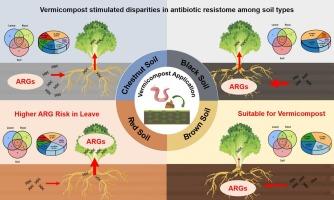Exploring the interaction between vermicompost application and soil types on the dispersal of antibiotic resistome above- and belowground
IF 5
2区 农林科学
Q1 SOIL SCIENCE
引用次数: 0
Abstract
Antibiotic resistance genes (ARGs) enter the human body through raw edible vegetables, posing a growing threat to public health. However, the influence of vermicompost on ARG migration within soil–vegetable systems, along with its relationship to soil types, remains largely unexplored. Herein, a microcosm experiment was used to explore the migration of antibiotic resistome in soil-vegetable systems under vermicompost application with four typical types of soil, including black, brown, red, and chestnut, using leafy plants (Lactuca sativa) as a model. The results showed that vermicompost facilitated the disparity in ARGs and bacterial communities across different soil–vegetable systems, while soil type played a decisive role in determining the risk of ARG spread. Under vermicompost application, ARGs displayed the highest migration potential to leaf endophytes in red soil, with an exogenous bioaccumulation factor (EBAF) of 25.36. In brown soil, the EBAF of ARGs in leaf endophytes was only 12.21, while inhibiting the migration of ARGs to edible leaves. Vermicompost regulated ARG dispersal both above- and belowground across different soil types by increasing microbial interactions and increasing network complexity during community coalescence in the soil–vegetable system. This study highlighted the increased health risk associated with red soil compared to other soil types and identified brown soil as the most suitable for vermicompost application.

探讨蚯蚓堆肥施用与土壤类型对抗生素抗性组地上、地下扩散的相互作用
抗生素耐药基因(ARGs)通过生食蔬菜进入人体,对公众健康构成越来越大的威胁。然而,蚯蚓堆肥对土壤-蔬菜系统中ARG迁移的影响及其与土壤类型的关系在很大程度上仍未被探索。本研究以叶植物(lacuca sativa)为模型,研究了蚯蚓堆肥在黑土、棕土、红土、栗土4种典型土壤类型下抗生素抗性组在土壤-蔬菜系统中的迁移。结果表明,蚯蚓堆肥促进了不同土壤-蔬菜系统中ARG和细菌群落的差异,而土壤类型对ARG传播风险起决定性作用。在蚯蚓堆肥处理下,ARGs对红壤叶片内生菌的迁移潜力最大,其外源生物积累因子(EBAF)为25.36。在棕壤中,叶片内生菌中ARGs的EBAF仅为12.21,抑制了ARGs向可食叶片的迁移。蚯蚓堆肥通过增加土壤-蔬菜系统中微生物相互作用和增加群落合并过程中网络复杂性来调节ARG在不同土壤类型上和地下的扩散。该研究强调,与其他土壤类型相比,红壤的健康风险增加,并确定棕色土壤最适合施用蚯蚓堆肥。
本文章由计算机程序翻译,如有差异,请以英文原文为准。
求助全文
约1分钟内获得全文
求助全文
来源期刊

Applied Soil Ecology
农林科学-土壤科学
CiteScore
9.70
自引率
4.20%
发文量
363
审稿时长
5.3 months
期刊介绍:
Applied Soil Ecology addresses the role of soil organisms and their interactions in relation to: sustainability and productivity, nutrient cycling and other soil processes, the maintenance of soil functions, the impact of human activities on soil ecosystems and bio(techno)logical control of soil-inhabiting pests, diseases and weeds.
 求助内容:
求助内容: 应助结果提醒方式:
应助结果提醒方式:


